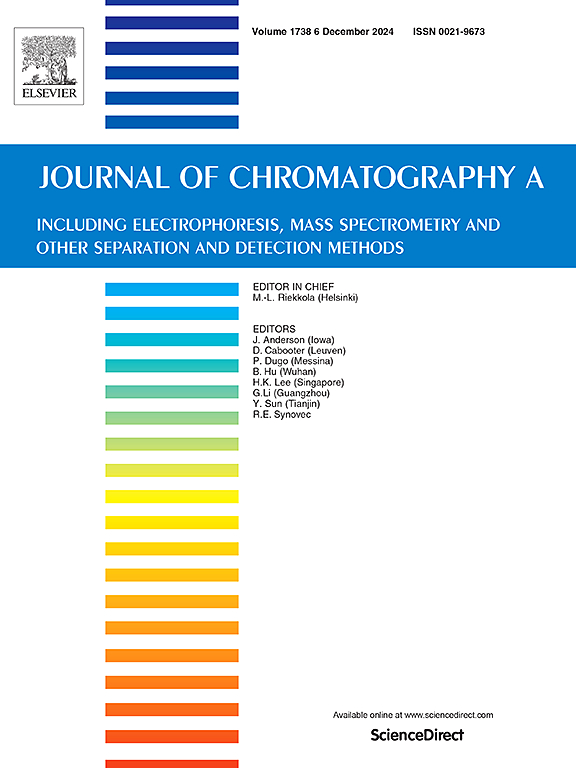评估汽车尾气中的 BTEX:使用 SPME 和 GC-BID 的快速高效方法。
IF 4
2区 化学
Q1 BIOCHEMICAL RESEARCH METHODS
引用次数: 0
摘要
苯、甲苯、乙苯和二甲苯异构体(间二甲苯、对二甲苯和邻二甲苯)(BTEX)因其对人体健康的有害影响而闻名,并已在各种环境基质中得到广泛研究。然而,由于基质的复杂性,对废气中的 BTEX 进行量化是一项挑战。本研究采用固相微萃取(SPME)和气相色谱法与介质阻挡放电离子化检测器(BID)相结合的方法开发策略,对怠速运转的内燃机排放的 BTEX 进行定量分析。使用 1.0 升 Tedlar 袋进行采样,然后提取等分样品,并使用专为气态样品设计的新型装置(刻度小瓶)用大气空气进行稀释。针对这些条件开发并验证了 SPME-GC-BID 方法:在 CAR/PDMS 75 μm 纤维中萃取 BTEX,接触时间为 5.0 分钟,温度为 27 °C,然后进行 GC-BID 分析。方法验证采用了检测限(LOD)和定量限(LOQ)、精密度和准确度(回收率)等指标,以确保定量结果的可靠性。检出限从 0.194 毫克/立方米到 0.340 毫克/立方米不等,定量限从 0.587 毫克/立方米到 1.03 毫克/立方米不等,精确度从 1.47%到 7.14%不等,回收率从 82.34%到 109.5%不等。汽车尾气中的 BTEX 浓度为 3.40 至 16.4 mg m-3。结果表明,就所分析的优点而言,SPME-GC-BID 方法在评估内燃机尾气中是否含有 BTEX 方面具有良好的灵敏度、精确度和准确度,有助于了解与汽车尾气排放有关的健康风险。本文章由计算机程序翻译,如有差异,请以英文原文为准。

Evaluating BTEX in vehicle exhaust gas: A fast and efficient approach using SPME and GC-BID
Benzene, toluene, ethylbenzene, and the xylene isomers (m, p, and o-xylene) (BTEX) are known for their harmful effects on human health and have been extensively studied across various environmental matrices. However, quantifying BTEX in exhaust gases poses challenges due to the complexity of the matrices. In this study, we investigated a method development strategy involving solid-phase microextraction (SPME) and gas chromatography coupled with a dielectric barrier discharge ionization Detector (BID) for quantifying BTEX emitted from internal combustion engines operating at idle. Sampling was conducted using 1.0 L Tedlar bags, followed by withdrawal of aliquots and dilution with atmospheric air using a novel device (graduated vial) designed for gaseous samples. The SPME-GC-BID method was developed and validated for the conditions: BTEX extraction in CAR/PDMS 75 μm fiber at a contact time of 5.0 min at a temperature of 27 °C, followed by GC-BID analysis. Method validation to ensure the reliability of quantitative results used the merit figures e.g., limits of detection (LOD) and quantification (LOQ), precision, and accuracy (recovery). LOD varied from 0.194 to 0.340 mg m−3, LOQ varied from 0.587 to 1.03 mg m−3, precision ranged from 1.47 to 7.14 %, and recovery varied from 82.34 to 109.5 %. BTEX concentration in vehicle exhaust varied from 3.40 to 16.4 mg m−3. The results showed, concerning the figures of merit analyzed, that the SPME-GC-BID method provides good sensibility, precision, and accuracy for evaluating the presence of BTEX in the exhaust of internal combustion engines, contributing to the understanding of health risks associated with vehicle emissions.
求助全文
通过发布文献求助,成功后即可免费获取论文全文。
去求助
来源期刊

Journal of Chromatography A
化学-分析化学
CiteScore
7.90
自引率
14.60%
发文量
742
审稿时长
45 days
期刊介绍:
The Journal of Chromatography A provides a forum for the publication of original research and critical reviews on all aspects of fundamental and applied separation science. The scope of the journal includes chromatography and related techniques, electromigration techniques (e.g. electrophoresis, electrochromatography), hyphenated and other multi-dimensional techniques, sample preparation, and detection methods such as mass spectrometry. Contributions consist mainly of research papers dealing with the theory of separation methods, instrumental developments and analytical and preparative applications of general interest.
 求助内容:
求助内容: 应助结果提醒方式:
应助结果提醒方式:


